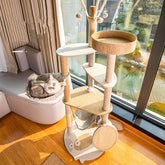A Comprehensive Guide to Applying Flea Serum on Cats: Ensuring Health and Comfort
Table of Contents
- Key Highlights:
- Introduction
- Choosing the Right Flea Serum
- The Application Process: A Step-by-Step Guide
- Potential Risks and Precautions
Key Highlights:
- Selecting the right flea serum is crucial; factors such as your cat's weight, age, and allergies must be considered.
- Proper application is essential for effectiveness; apply the serum directly onto the skin and prevent licking.
- Awareness of potential risks, including skin irritation and toxicity, is vital for safe use.
Introduction
Flea infestations can lead to significant discomfort for cats and pose health risks if left untreated. As a responsible pet owner, understanding how to effectively apply flea serum is essential for your cat’s well-being. The right flea treatment not only helps alleviate itching and discomfort caused by fleas but also prevents further infestations. This guide will delve into the intricacies of selecting and applying flea serum safely, as well as addressing common concerns pet owners may have.
Choosing the Right Flea Serum
Before applying flea serum, it is crucial to select the appropriate product tailored for your feline companion. Not all flea treatments are created equal, and using an unsuitable product can lead to ineffective treatment or even harm your cat.
Consider Your Cat’s Weight and Age
Flea serums are formulated with varying concentrations of active ingredients, specifically designed for cats of different weights and ages. Kittens and senior cats often require specially formulated treatments due to their unique vulnerabilities. Always consult your veterinarian prior to selecting a flea serum, particularly for young or elderly pets, as their health can be significantly impacted by inappropriate products. Importantly, never use dog flea treatments on cats, as many contain permethrin, a substance highly toxic to felines.
Evaluate Ingredients and Potential Allergies
Different flea serums utilize various active ingredients such as fipronil, imidacloprid, selamectin, or spinosad. It is vital to research these ingredients for potential side effects or contraindications. If your cat has a history of allergies or sensitivities, engage in a conversation with your veterinarian to identify products with minimal risk of adverse reactions. In cases of highly sensitive cats, considering natural flea treatments may be an option, although these may require more frequent applications and could be less effective.
Select a Reputable Brand
When choosing a flea serum, opt for well-established brands that have undergone rigorous testing and have a proven track record of safety and efficacy. Purchasing flea serums from unverified sources can be dangerous, as counterfeit products may not deliver the promised results and could pose health risks to your cat.
The Application Process: A Step-by-Step Guide
Once you have selected the right flea serum, understanding the application process is essential for maximizing its efficacy.
Prepare Your Cat and the Treatment
Preparation is key to a successful application. Follow these steps:
- Read the Instructions: Each product differs in application. Carefully read the label and instructions before starting.
- Gather Your Supplies: Have the flea serum ampoule or applicator ready along with a towel (if needed) and some treats as a reward.
- Choose a Quiet Environment: Select a calm space where your cat feels secure, reducing the chance of agitation during application.
- Distract Your Cat: Engage your cat with a treat or a favorite toy to keep them occupied during the process.
Applying the Serum
Correct application is vital for ensuring the flea serum's effectiveness. Here are the steps to follow:
- Part the Fur: Locate the application area, typically at the base of the skull or between the shoulder blades. Part the fur to expose the skin, which is crucial for direct application.
- Apply the Serum: Position the applicator tip directly against the exposed skin and dispense the entire contents of the ampoule. It is important to avoid applying the serum on your cat's fur, as this can reduce its effectiveness and pose a risk if your cat grooms itself afterward.
- Avoid Over-Application: Adhere to the recommended dosage. Applying more than directed can increase the risk of side effects.
- Monitor for Reactions: After application, observe your cat for any signs of skin irritation, excessive drooling, vomiting, or lethargy. If any adverse reactions occur, contact your veterinarian immediately.
Post-Application Care
After applying the flea serum, there are additional care steps to ensure its success and your cat's safety:
- Prevent Licking: Keep a close eye on your cat to deter them from licking the application site. Use toys or treats to distract them if necessary. In persistent cases, an Elizabethan collar may be required to prevent licking.
- Wash Your Hands: Thoroughly clean your hands with soap and water following the application to eliminate any residue.
- Monitor for Effectiveness: Regularly check your cat for fleas. Most flea serums begin to work within 24-48 hours, but the duration of effectiveness can vary based on the specific product used.
Potential Risks and Precautions
While flea serums are generally safe when applied correctly, it is important to be aware of potential risks associated with their use.
Skin Irritation and Allergic Reactions
Some cats may exhibit skin irritation or allergic reactions to flea serums. Symptoms can include redness, itching, hair loss, or hives. Should your cat show any of these signs, discontinue use of the product and consult your veterinarian for further guidance.
Toxicity
Incorrect application or accidental ingestion of flea serum can lead to toxicity, especially in kittens or cats with pre-existing health conditions. Signs of toxicity may include excessive drooling, vomiting, muscle tremors, seizures, or difficulty breathing. Immediate veterinary attention is crucial if you suspect your cat has ingested flea serum.
Human Exposure
Flea serums can pose risks to humans if they come into contact with skin or are ingested. Always wear gloves during application and wash your hands thoroughly afterward. It is also important to keep flea serums stored out of reach from children and pets.
FAQ
Here are some frequently asked questions regarding the application of flea serum on cats:
Q1: How often should I apply flea serum to my cat?
The frequency of application depends on the specific product. Typically, flea serums are applied monthly, but some may require more frequent applications during peak flea seasons. Always adhere to the product label for specific instructions.
Q2: What if my cat vomits after I apply flea serum?
Vomiting can indicate toxicity, particularly if it occurs shortly after application. Contact your veterinarian immediately. They may suggest inducing vomiting or provide supportive care.
Q3: Can I bathe my cat after applying flea serum?
It is advisable to avoid bathing your cat for at least 48 hours post-application. Bathing can wash away the treatment, reducing its effectiveness. Always check the product label for specific recommendations, as some shampoos may interfere with the serum’s active ingredients.
Q4: My cat licked the flea serum. What should I do?
Monitor your cat closely for any signs of toxicity, such as excessive drooling or vomiting. If you observe any adverse reactions, contact your veterinarian. They may recommend administering activated charcoal or providing supportive care.
Q5: Can I apply flea serum to a pregnant or nursing cat?
Not all flea serums are safe for pregnant or nursing cats. Consulting your veterinarian before applying any flea treatment to these cats is essential for ensuring their safety.
Q6: What if I miss a dose of flea serum?
If you forget a dose, apply the serum as soon as you remember. However, avoid administering a double dose; simply resume your regular application schedule.
Q7: Can I use flea serum alongside other flea control methods?
Combining flea serum with additional flea control methods, such as collars or oral medications, can elevate the risk of toxicity. It is prudent to consult your veterinarian before using multiple flea control products concurrently.
Q8: How long does it take for flea serum to kill fleas?
Most flea serums begin to kill fleas within 24-48 hours, although it may take several days to weeks to eliminate all fleas from your cat and their environment.
Q9: How do I dispose of the flea serum applicator?
Follow the disposal instructions on the product label. Most applicators can be discarded in the trash. Never attempt to reuse the applicator.
Q10: How can I prevent flea infestations in the future?
Regularly vacuum your home, wash your pet’s bedding, and treat your yard for fleas. Consider utilizing flea preventatives year-round, even during winter months. Early detection and preventative measures are key to maintaining a flea-free environment for your cat.
By adhering to these guidelines and seeking advice from your veterinarian, you can apply flea serum safely and effectively to your cat, ensuring their comfort and health. Remember, prevention is always more effective than treatment, so regular flea control is essential for a happy, healthy feline companion.





